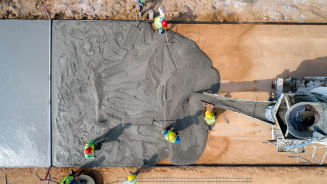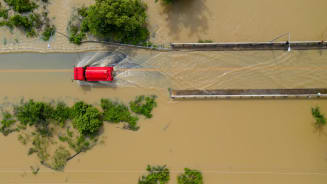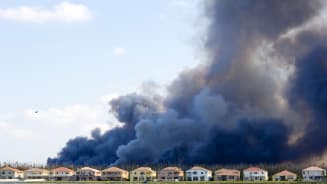
Support
The original attacker tactic introduced with DNSForge facilitates a DNS poisoning attack that leverages ARP spoofing to achieve an adversary-in-the-middle condition. This initial attack mode (termed as “respond” mode) induces on-path hosts to treat the attacking host as the DNS server and route subsequent DNS requests accordingly. To achieve this, DNSForge issues ARP broadcasts advertising that the legitimate DNS server’s IP address is available at the attacking host’s MAC address. Once the attacking host receives a valid DNS request, DNSForge issues a DNS response based on validation parameters supplied by the operator. In this “respond” mode, DNSForge acts as a rogue DNS server and is expected to fulfill all requests from all DNS clients since the legitimate DNS server is no longer reachable by clients who accepted the spoofed ARP entry. Thereby, this mode expects the operator to set a legitimate DNS server’s IP address as the ARP spoofing target.

This blog post introduces the “relay” mode that achieves interception of a victim client’s DNS response while it is on the way back to the client. In this mode, the ARP spoofing target is set to victim clients on the same subnet, which results in DNSForge issuing ARP broadcasts advertising that the victim clients’ IP addresses are available at the attacking host’s MAC address. These broadcasts poison the ARP cache of the gateway (in the case the DNS server resides outside the attacking machine’s subnet) and/or the DNS server when it resides on the same subnet as the attacking machine. Therefore, the DNS response that is on its way back from the server to the victim client is received by DNSForge on the attacking machine. At this stage, DNSForge performs modifications to the DNS response issued by the legitimate DNS server (such as the resolved IP address) and forwards the packet to the victim client.

The addition of the relay mode allows for greater flexibility given the operator’s situation and attack context. In some cases, this mode can provide greater efficiency and reduced network load as well.
For instance, when DNSForge runs in respond mode and the DNS server resides outside the attacking machine’s subnet, the ARP spoofing target is set to the gateway. The tool ensures that IP forwarding is enabled to prevent denial-of-service on the subnet as with the ARP spoofing target set to the gateway, all traffic that leaves the subnet is routed via the attacking machine. IP forwarding ensures network reliability for victim clients that reside on the same subnet as the attacking machine. Nevertheless, processing traffic for the entire subnet can overwhelm the attacking machine. Even more so, this approach may seem wasteful as DNSForge will only poison DNS requests that match validation parameters, which will be a small percentage of all observed network traffic.
However, with the newly introduced relay mode, DNSForge can simply be configured to perform ARP spoofing against victim clients and so the tool will intercept DNS responses on their way back from the DNS server. In this setting, an operator can specifically target one or more victim clients on the same subnet and only intercept traffic that’s destined for those clients. Therefore, in this scenario, the relay mode improves the efficiency of the attack.
In another example, an operator may use respond mode when the network landscape is relatively unfamiliar and hence impersonating a DNS server will achieve credential capture for all clients – this approach is synonymous to carpet bombing the entire subnet. On the other hand, an operator may use the relay mode when the details of on-path clients are well known and hence DNS requests from only a handful of clients need to be poisoned – this approach is synonymous to a precision airstrike on hand-picked targets. This customization allows operators to pick their specific goal with the added benefit of improving the stealthiness of the attack.
Finally, since the relay mode improves the consistency of credential interception, it can be effectively paired up with Impacket’s ntlmrelayx.py to perform credential relaying attacks. As compared to a pairing with Responder that simply captures hashed credentials, ntlmrelayx can relay authenticated inbound connections to one of many services that are available in an Active Directory environment such as SMB, LDAP/S or HTTP/S. This provides greater flexibility in environments where cracking captured hashes proves challenging. Relaying the credential allows the operator to assume authenticated access to the relayed service without having to crack the hash. Moreover, since DNSForge can target DNS requests for WPAD that result in interactions over HTTP, the inbound authentications can be relayed while bypassing SMB signing restrictions.
A sample attack scenario is as follows: an attacker identifies a client on the same subnet that is used by a network administrator who has a highly privileged active directory user account. This user has set an extremely complex and long password, which makes password cracking unrealistic and hence a credential relaying attack is more reasonable.
First, the attacker sets up DNSForge in relay mode to specifically target the identified client:
$ sudo dnsforge relay -i <interface> -p <attacker-ip> -t <client-ip> -q wpadNext, the attacker sets up ntlmrelayx to first serve a PAC file and subsequently relay inbound HTTP connections to the LDAPS service on the domain controller. This will dump domain information such as users, groups, OUs, password policy and more. However, this command can be modified to perform other actions such as elevate privileges, add computer accounts and more.
$ impacket-ntlmrelayx -t ldaps://<domain-controller-ip> -wh <attacker-ip>
Note: If you previously ran Responder instead of ntlmrelayx to serve the PAC file to the client, it advertises the HTTP proxy on port 3128 as compared to port 80 used by ntlmrelayx. Hence, clients that have already registered the PAC file from Responder may not route connections via ntlmrelayx’s rogue proxy server at port 80 until the PAC file from ntlmrelayx is registered. To overcome this, ntlmrelayx can be configured to run the HTTP server on a custom port:
$ impacket-ntlmrelayx -t ldaps://<domain-controller-ip> -wh <attacker-ip> --http-port 3128

Support
This blog post and updated tool provide additional capabilities to operators allowing greater customizability based on the network context and attack goals. The newly added “relay” mode allows for highly targeted attacks against specific clients – improving operational stealth and minimizing disruptions. The code for DNSForge can be found here: https://github.com/AonCyberLabs/DNSForge
Capability Overview
Cyber Resilience
Product / Service
Penetration Testing Services
About Cyber Solutions:
Cyber security services are offered by Stroz Friedberg Inc., its subsidiaries and affiliates. Stroz Friedberg is part of Aon’s Cyber Solutions which offers holistic cyber risk management, unsurpassed investigative skills, and proprietary technologies to help clients uncover and quantify cyber risks, protect critical assets, and recover from cyber incidents.
General Disclaimer
This material has been prepared for informational purposes only and should not be relied on for any other purpose. You should consult with your own professional advisors or IT specialists before implementing any recommendation, following any of the steps or guidance provided herein. Although we endeavor to provide accurate and timely information and use sources that we consider reliable, there can be no guarantee that such information is accurate as of the date it is received or that it will continue to be accurate in the future.
Terms of Use
The contents herein may not be reproduced, reused, reprinted or redistributed without the expressed written consent of Aon, unless otherwise authorized by Aon. To use information contained herein, please write to our team.
Stay in the loop on today's most pressing cyber security matters.
View All
Cyber Labs 7 mins
DNSForge – Relaying with Force
Cyber Labs 14 mins
We’re All in This Together: The Case for Purple Teaming
Cyber Labs 7 mins
Parsing ESXi Logs for Incident Response with QELP
Cyber Labs 5 mins
Parsing Jenkins Configuration Files for Forensics and Fun
Cyber Labs 10 mins
Emerging Risks in Third-Party AI Solutions and How to Help Address Them
Cyber Labs 20 mins
Unveiling the Dark Side: Common Attacks and Vulnerabilities in Industrial Control Systems
Cyber Labs 9 mins
Mounted Guest EDR Bypass
Cyber Labs 6 mins
Optimizing Your Cyber Resilience Strategy Through CISO and CRO Connectivity
Cyber Labs 9 mins
Bypassing EDR through Retrosigned Drivers and System Time Manipulation
Cyber Labs 10 mins
DNSForge – Responding with Force
Cyber Labs 7 mins
Unveiling "sedexp": A Stealthy Linux Malware Exploiting udev Rules
Cyber Labs 3 mins
Command Injection and Path Traversal in StoneFly Storage Concentrator
Cyber Labs 7 mins
Adopt an AI Approach with Confidence, for CISOs and CIOs
Cyber Labs 3 mins
Responding to the CrowdStrike Outage: Implications for Cyber and Technology Professionals
Cyber Labs 10 mins
DUALITY Part II - Initial Access and Tradecraft Improvements
Cyber Labs 17 mins
Cracking Into Password Requirements
Cyber Labs 57 mins
DUALITY: Advanced Red Team Persistence through Self-Reinfecting DLL Backdoors for Unyielding Control
Cyber Labs 7 mins
Restricted Admin Mode – Circumventing MFA On RDP Logons
Cyber Labs 9 mins
Detecting “Effluence”, An Unauthenticated Confluence Web Shell
Cyber Labs 10 mins
Flash Loan Attacks: A Case Study
Ready to Explore Further?
Sign up to receive updates on the latest events, insights, news and more from our team.
Our Better Being podcast series, hosted by Aon Chief Wellbeing Officer Rachel Fellowes, explores wellbeing strategies and resilience. This season we cover human sustainability, kindness in the workplace, how to measure wellbeing, managing grief and more.

Podcast 23 mins
Better Being Series: Understanding Burnout in the Workplace
Podcast 14 mins
Better Being Series: Why Nutrition Matters
Podcast 10 mins
Better Being Series: Discover the ‘Blue Zones’ Where People Live Longer
Podcast 20 mins
Better Being Series: Improving Your Financial Wellbeing
Podcast 17 mins
Better Being Series: Are You Taking Care of Your Digital Wellbeing?
Podcast 19 mins
On Aon Podcast: Better Being Series Dives into Women’s Health
Podcast 29 mins
On Aon’s Better Being Series: The World Wellbeing Movement
Podcast 28 mins
On Aon’s Better Being Series: Mental Health and Creating Kinder Cultures
Podcast 25 mins
On Aon’s Better Being Series: Managing Loss and Grief
Podcast 24 mins
On Aon’s Better Being Series: Measuring Wellbeing
Podcast 25 mins
On Aon’s Better Being Series: Physical Wellbeing and Resilience
Podcast 24 mins
On Aon’s Better Being Series: Human SustainabilityExpert Views on Today's Risk Capital and Human Capital Issues

Article 8 mins
Thriving in an Interconnected World: How the C-Suite Embraces Uncertainty
Article 6 mins
Powering Progress: Collaborating to Build a Sustainable Future in Emerging Markets
Article 5 mins
Building Business Resilience: Key Steps to Effectively Integrate Risk Management Across Your Organisation
Article 7 mins
Why Humans Are the Essential Factor in the Success of Artificial Intelligence (AI)
Article 5 mins
Leveraging Research and Expertise to Strengthen Your HR Strategy for 2025 and Beyond
Article 5 mins
Managing Risk on the Energy Transition Journey
Article 7 mins
The Role of Risk Management in the Age of Generative Artificial Intelligence
Article 7 mins
Finding A Way In Asia Pacific's New Economic Reality
Article 4 mins
Three Ways to Boost Value from Benefits: APAC Insights from LinkedInExpert Views on Today's Risk Capital and Human Capital Issues
Expert Views on Today's Risk Capital and Human Capital Issues

Article 2 mins
Introduction: Clarity and Confidence to Make Better Decisions
Article 2 mins
The Age of Rising Resilience – An Economic Outlook
Article 3 mins
Building Resilience Against the Constant Cyber Threat
Article 2 mins
Making Better Decisions – A Treasurer’s Perspective
Article 2 mins
How to Balance the Conflicting Forces of Efficiency, Performance and Wellbeing
Article 3 mins
Seizing the Opportunity: Building a Comprehensive Approach to Risk Transfer
Article 2 mins
Tapping New Markets to Unlock Deal Value
Article 5 mins
The Rise of the Skills-Based Organisation
Article 2 mins
Creating a Fair and Equitable Workforce for Everyone
Article 3 mins
The Year of the Vote: How Geopolitical Volatility Will Impact Businesses
Article 2 mins
The Aon DifferenceThe construction industry is under pressure from interconnected risks and notable macroeconomic developments. Learn how your organization can benefit from construction insurance and risk management.

Article 8 mins
How North American Construction Contractors Can Mitigate Emerging Risks
Article 7 mins
Managing Construction Risks: 7 Risk Advisory Steps
Article 7 mins
Unlocking Capacity and Capital in a Challenging Construction Risk Market
Article 7 mins
Protecting North American Contractors from Extreme Heat Risks with Parametric
Article 5 mins
How Climate Modeling Can Mitigate Risks and Improve Resilience in the Construction Industry
Report 1 mins
Construction Risk Management Europe Report 2023
Article 8 mins
Parametric Can Help Mitigate Extreme Heat Risks for Contractors in EMEA
Article 9 mins
How the Construction Industry is Navigating Climate Change
Article 11 mins
Top Risks Facing Construction and Real Estate OrganizationsStay in the loop on today's most pressing cyber security matters.

Cyber Labs 7 mins
DNSForge – Relaying with Force
Cyber Labs 14 mins
We’re All in This Together: The Case for Purple Teaming
Cyber Labs 7 mins
Parsing ESXi Logs for Incident Response with QELP
Cyber Labs 5 mins
Parsing Jenkins Configuration Files for Forensics and Fun
Cyber Labs 10 mins
Emerging Risks in Third-Party AI Solutions and How to Help Address Them
Cyber Labs 20 mins
Unveiling the Dark Side: Common Attacks and Vulnerabilities in Industrial Control Systems
Cyber Labs 9 mins
Mounted Guest EDR Bypass
Cyber Labs 6 mins
Optimizing Your Cyber Resilience Strategy Through CISO and CRO Connectivity
Cyber Labs 9 mins
Bypassing EDR through Retrosigned Drivers and System Time Manipulation
Cyber Labs 10 mins
DNSForge – Responding with Force
Cyber Labs 7 mins
Unveiling "sedexp": A Stealthy Linux Malware Exploiting udev Rules
Cyber Labs 3 mins
Command Injection and Path Traversal in StoneFly Storage Concentrator
Cyber Labs 7 mins
Adopt an AI Approach with Confidence, for CISOs and CIOs
Cyber Labs 3 mins
Responding to the CrowdStrike Outage: Implications for Cyber and Technology Professionals
Cyber Labs 10 mins
DUALITY Part II - Initial Access and Tradecraft Improvements
Cyber Labs 17 mins
Cracking Into Password Requirements
Cyber Labs 57 mins
DUALITY: Advanced Red Team Persistence through Self-Reinfecting DLL Backdoors for Unyielding Control
Cyber Labs 7 mins
Restricted Admin Mode – Circumventing MFA On RDP Logons
Cyber Labs 9 mins
Detecting “Effluence”, An Unauthenticated Confluence Web Shell
Cyber Labs 10 mins
Flash Loan Attacks: A Case StudyOur Cyber Resilience collection gives you access to Aon’s latest insights on the evolving landscape of cyber threats and risk mitigation measures. Reach out to our experts to discuss how to make the right decisions to strengthen your organization’s cyber resilience.

Article 7 mins
How to Navigate AI-Driven Cyber Risks
Article 9 mins
Building Resilience in a Buyer-Friendly Cyber and E&O Market
Article 11 mins
A Middle Market Roadmap for Cyber Resilience
Article 7 mins
Lessons Learned from the CrowdStrike Outage: 5 Strategies to Build Cyber Resilience
Article 8 mins
Responding to Cyber Attacks: How Directors and Officers and Cyber Policies Differ
Article 7 mins
Why Now is the Right Time to Customize Cyber and E&O Contracts
Article 6 mins
8 Steps Toward Building Better Resilience Against Rising Ransomware Attacks
Article 7 mins
Mitigating Insider Threats: Managing Cyber Perils While Traveling Globally
Article 5 mins
Managing Cyber Risk through Return on Security Investment
Article 10 mins
Mitigating Insider Threats: Your Worst Cyber Threats Could be Coming from Inside
Article 9 mins
Why HR Leaders Must Help Drive Cyber Security Agenda
Article 10 mins
Escalating Cyber Security Risks Mean Businesses Need to Build ResilienceOur Employee Wellbeing collection gives you access to the latest insights from Aon's human capital team. You can also reach out to the team at any time for assistance with your employee wellbeing needs.

Article 8 mins
Employer Strategies for Cancer Prevention and Treatment
Article 6 mins
The Long-Term Care Conundrum in the United States
Article 9 mins
Developing a Paid Leave Strategy That Supports Workers and Their Families
Article 9 mins
4 Ways to Foster a Thriving Workforce Amid Rising Health Costs
Article 9 mins
The Next Evolution of Wellbeing is About Performance
Article 6 mins
Three Ways Collective Retirement Plans Support HR Priorities
Article 9 mins
How the Right Employee Wellbeing Strategy Impacts Microstress and Burnout at Work
Podcast 13 mins
On Aon Podcast: The Future of Healthcare: Key Factors Impacting Medical Trend Rates
Article 7 mins
Making Wellbeing Part of a Company’s DNA
Article 7 mins
COVID-19 has Permanently Changed the Way We Think About WellbeingExplore Aon's latest environmental social and governance (ESG) insights.

Podcast 16 mins
On Aon Podcast: Approach to DE&I in the WorkplaceOur Global Insurance Market Insights highlight insurance market trends across pricing, capacity, underwriting, limits, deductibles and coverages.

Article 12 mins
Q4 2023: Global Insurance Market Overview
Article 13 mins
Top Risk Trends to Watch in 2024How do the top risks on business leaders’ minds differ by region and how can these risks be mitigated? Explore the regional results to learn more.

Article 12 mins
Top Risks Facing Organizations in Asia Pacific
Article 12 mins
Top Risks Facing Organizations in North America
Article 10 mins
Top Risks Facing Organizations in Europe
Article 8 mins
Top Risks Facing Organizations in Latin America
Article 8 mins
Top Risks Facing Organizations in the Middle East and Africa
Article 9 mins
Top Risks Facing Organizations in the United KingdomOur Human Capital Analytics collection gives you access to the latest insights from Aon's human capital team. Contact us to learn how Aon’s analytics capabilities helps organizations make better workforce decisions.

Article 35 mins
5 Human Resources Trends to Watch in 2025
Article 13 mins
Medical Rate Trends and Mitigation Strategies Across the Globe
Article 9 mins
3 Strategies to Help Avoid Workers Compensation Claims Litigation
Podcast 15 mins
On Aon Podcast: Using Data and Analytics to Improve Health Outcomes
Article 14 mins
How Technology Will Transform Employee Benefits in the Next Five Years
Podcast 18 mins
On Aon Podcast: Technology Impacting the Future of Health and Benefits
Article 8 mins
Integrating Workforce Data to Uncover Hidden Insights
Podcast 24 mins
On Aon’s Better Being Series: Measuring Wellbeing
Article 11 mins
Designing Tomorrow: Personalizing EVP, Benefits and Total RewardsExplore our hand-picked insights for human resources professionals.

Article 7 mins
COVID-19 has Permanently Changed the Way We Think About Wellbeing
Article 7 mins
DE&I in Benefits Plans: A Global Perspective
Article 10 mins
How Data and Analytics Can Optimize HR Programs
Article 9 mins
Why HR Leaders Must Help Drive Cyber Security Agenda
Article 7 mins
Case Study: The LPGA Unlocks Talent Potential with Data
Article 11 mins
Navigating the New EU Directive on Pay Transparency
Article 4 mins
How to Design Better Talent Assessment to Promote DE&I
Article 6 mins
Training and Transforming Managers for the Future of Work
Article 7 mins
Rethinking Your Total Rewards Programs During Mergers and Acquisitions
Article 14 mins
Building a Resilient Workforce That Steers Organizational Success | An Outlook Across IndustriesOur Workforce Collection provides access to the latest insights from Aon’s Human Capital team on topics ranging from health and benefits, retirement and talent practices. You can reach out to our team at any time to learn how we can help address emerging workforce challenges.

Article 35 mins
5 Human Resources Trends to Watch in 2025
Report 13 mins
A Workforce in Transition Prepares to Meet a Host of Challenges
Article 8 mins
2025 Salary Increase Planning Tips
Report 1 mins
The Global Medical Trend Rates Report 2025
Article 9 mins
The Next Evolution of Wellbeing is About Performance
Article 12 mins
Understanding and Preparing for the Rise in Pay Transparency
Podcast 12 mins
Special Edition: Building a Total Rewards Plan for Every Employee
Article 7 mins
Key Trends in U.S. Benefits for 2025 and Beyond
Article 8 mins
Pay Transparency Can Lead to Better Equity Across Benefits
Article 17 mins
3 Strategies to Improve Career Outcomes for Older Employees
Article 9 mins
Developing a Paid Leave Strategy That Supports Workers and Their Families
Article 9 mins
4 Ways to Foster a Thriving Workforce Amid Rising Health CostsOur Mergers and Acquisitions (M&A) collection gives you access to the latest insights from Aon's thought leaders to help dealmakers make better decisions. Explore our latest insights and reach out to the team at any time for assistance with transaction challenges and opportunities.

Article 8 mins
Exit Strategy Value Creation Opportunities Exist as Economic Pressures Persist
Article 5 mins
Future Trends for Financial Sponsors: Secondary Transactions
Article 7 mins
3 Ways to Unlock M&A Value in a Challenging Credit Environment
Article 7 mins
Rethinking Your Total Rewards Programs During Mergers and Acquisitions
Article 9 mins
Organizational Design and Talent Planning are Key to M&A Success
Article 7 mins
An Ever-Complex Global Tax Environment Requires Strong M&A Risk Solutions
Article 6 mins
Project Management for HR: The Secret Behind a Successful M&A Deal
Article 9 mins
Cultural Alignment Planning Drives M&A Success
Report 1 mins
A Guide to Maximizing Value in Post-Merger Integrations
Report 2 mins
The ABC's of Private Equity M&A: Deal Flow Impacts of Al, Big Tech and Climate Change
Article 11 mins
The Silver Lining on M&A Deal Clouds: M&A Insurance Insights from 2023How do businesses navigate their way through new forms of volatility and make decisions that protect and grow their organizations?
Our Parametric Insurance Collection provides ways your organization can benefit from this simple, straightforward and fast-paying risk transfer solution. Reach out to learn how we can help you make better decisions to manage your catastrophe exposures and near-term volatility.

Article 10 mins
How Public Entities and Businesses Can Use Parametric for Emergency Funding
Article 6 mins
Parametric Insurance: A Complement to Traditional Property Coverage
Article 8 mins
Using Parametric Insurance to Match Capital to Climate Risk
Article 6 mins
Using Parametric Insurance to Close the Earthquake Protection Gap
Article 5 mins
How Technology Enhancements are Boosting ParametricOur Pay Transparency and Equity collection gives you access to the latest insights from Aon's human capital team on topics ranging from pay equity to diversity, equity and inclusion. Contact us to learn how we can help your organization address these issues.

Article 19 mins
3 Strategies to Promote an Inclusive Environment and Bridge the Gender Gap
Report 1 mins
The 2024 North America Pay Transparency Readiness Study
Article 10 mins
How Financial Institutions can Prepare for Pay Transparency Legislation
Article 8 mins
Pay Transparency Can Lead to Better Equity Across Benefits
Article 12 mins
Understanding and Preparing for the Rise in Pay Transparency
Podcast 14 mins
On Aon Podcast: Understanding Pay Transparency Regulations
Article 11 mins
Navigating the New EU Directive on Pay Transparency
Article 7 mins
To Disclose Pay or Not? How Companies are Approaching the Pay Transparency Movement
Podcast 19 mins
On Aon Podcast: Better Being Series Dives into Women’s Health
Article 11 mins
Advancing Women’s Health and Equity Through Benefits and SupportForecasters are predicting an extremely active 2024 Atlantic hurricane season. Take measures to build resilience to mitigate risk for hurricane-prone properties.

Article 8 mins
Florida Hurricanes Not Expected to Adversely Affect Property Market
Article 10 mins
Build Resilience for an Extremely Active Atlantic Hurricane Season
Article 6 mins
Four Steps to Develop Strong Property Risk Coverage in a Hardening Market
Podcast 16 mins
On Aon Podcast: Navigating and Preparing for Catastrophes
Article 6 mins
Parametric Insurance: A Complement to Traditional Property Coverage
Article 6 mins
Navigating Climate Risk Using Multiple Models and Data Sets
Article 5 mins
Rising Losses From Severe Convection Storms Mostly Explained by Exposure Growth
Article 6 mins
Using Parametric Insurance to Close the Earthquake Protection GapOur Technology Collection provides access to the latest insights from Aon's thought leaders on navigating the evolving risks and opportunities of technology. Reach out to the team to learn how we can help you use technology to make better decisions for the future.

Article 23 mins
The AI Data Center Boom: Strategies for Sustainable Growth and Risk Management
Article 7 mins
How to Navigate AI-Driven Cyber Risks
Article 16 mins
How Artificial Intelligence is Transforming Human Resources and the Workforce
Report 18 mins
Evolving Technologies Are Driving Firms to Harness Opportunities and Defend Against Threats
Alert 3 mins
Better Decisions Brief: Perspectives on the CrowdStrike Outage
Podcast 9 mins
On Aon Podcast: How has CrowdStrike Changed the Cyber Market?
Article 12 mins
5 Ways Artificial Intelligence can Boost Claims Management
Article 12 mins
Navigating AI-Related Risks: A Guide for Directors and Officers
Article 9 mins
Overcoming the Reputational Cost of Cyber Attacks: The 10-Day Plan
Article 9 mins
Why HR Leaders Must Help Drive Cyber Security Agenda
Article 5 mins
How Technology Enhancements are Boosting Parametric
Article 9 mins
How to Futureproof Data and Analytics Capabilities for ReinsurersTrade, technology, weather and workforce stability are the central forces in today’s risk landscape.

Article 7 mins
Cyber Attack or Data Breach
Article 4 mins
Business Interruption
Article 4 mins
Economic Slowdown or Slow Recovery
Article 5 mins
Failure to Attract or Retain Top Talent
Article 5 mins
Regulatory or Legislative Changes
Article 4 mins
Supply Chain or Distribution Failure
Article 6 mins
Commodity Price Risk or Scarcity of Materials
Article 4 mins
Damage to Brand or Reputation
Article 5 mins
Failure to Innovate or Meet Customer Needs
Article 4 mins
Increasing Competition
Report 3 mins
Business Decision Maker SurveyOur Trade Collection gives you access to the latest insights from Aon's thought leaders on navigating the evolving risks and opportunities for international business. Reach out to our team to understand how to make better decisions around macro trends and why they matter to businesses.

Podcast 9 mins
Special Edition: Global Trade and its Impact on Supply Chain
Article 8 mins
The Evolving Threat of Cargo Theft: 5 Key Mitigation Strategies
Report 3 mins
Global Risk Management Survey
Report 15 mins
Wide-Ranging Trade Issues Confront Global Businesses on Multiple Fronts
Article 6 mins
Four Steps to Develop Strong Property Risk Coverage in a Hardening Market
Article 14 mins
Cutting Supply Chains: How to Achieve More Reward with Less Risk
Article 9 mins
Driving Private Equity Value Creation Through Credit Solutions
Article 7 mins
4 Steps to Help Take Advantage of a Buyer-Friendly Directors' & Officers' Market
Article 9 mins
Managing Reputational Risks in Global Supply Chains
Article 6 mins
How an Outsourced Chief Investment Officer Can Help Improve Governance and Manage Complexity
Article 8 mins
Decarbonizing Your Business: Finding the Right Insurance and Strategy
Article 8 mins
Reputation Analytics as a Leading Indicator of ESG RiskWith a changing climate, organizations in all sectors will need to protect their people and physical assets, reduce their carbon footprint, and invest in new solutions to thrive. Our Weather Collection provides you with critical insights to be prepared.

Podcast 9 mins
On Aon Podcast: Climate Impact on the Property and Casualty Market
Alert 14 mins
L.A. Wildfires Highlight Urgent Need for Employee Support and Business Resilience
Report 17 mins
Climate Analytics Unlock Capital to Protect People and Property
Report 2 mins
Climate and Catastrophe Insight
Article 10 mins
How Public Entities and Businesses Can Use Parametric for Emergency Funding
Podcast 12 mins
On Aon Podcast: Tackling Climate Risk to Build Economic Resilience
Article 8 mins
Understanding Freeze Risk in a Changing Climate
Podcast 9 mins
On Aon Podcast: Climate Science Through Academic Collaboration
Article 6 mins
How Companies Are Using Climate Modeling to Improve Risk Decisions
Article 8 mins
Using Parametric Insurance to Match Capital to Climate Risk
Article 9 mins
How the Construction Industry is Navigating Climate Change
Article 9 mins
Record Heatwaves: Protecting Employee Health and SafetyOur Workforce Resilience collection gives you access to the latest insights from Aon's Human Capital team. You can reach out to the team at any time for questions about how we can assess gaps and help build a more resilience workforce.

Article 4 mins
Using Data to Close Workforce Gaps in Financial Institutions
Article 5 mins
Using Data to Close Workforce Gaps in Retail Companies
Article 7 mins
Using Data to Close Workforce Gaps in Technology Companies
Article 5 mins
Using Data to Close Workforce Gaps in Manufacturing Companies
Article 6 mins
Using Data to Close Workforce Gaps in Life Sciences Companies
Report 4 mins
Measure Workforce Resilience for Better Business Outcomes
Podcast 18 mins
On Aon Podcast: Methodology to Predict Employee Performance for the LPGA
Article 6 mins
Training and Transforming Managers for the Future of Work
Article 14 mins
Building a Resilient Workforce That Steers Organizational Success | An Outlook Across IndustriesYou will soon receive an email to verify your email address. Please click on the link included in this note to complete the subscription process, which also includes providing consent in applicable locations and an opportunity to manage your email preferences.

Article 5 Min Read

Article 10 Min Read
Your request is being reviewed so we can align you to the best resources on our team. In the meantime, we invite you to explore some of our latest insights below.

Article 5 Min Read

Article 10 Min Read
If you encounter an issue, use the link below to start a new download.
Download Now